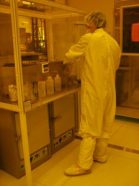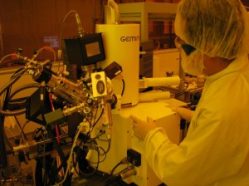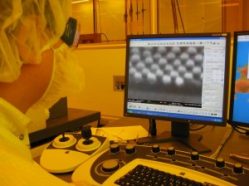Letting molecules do the work
Why go to the trouble of carefully building electric circuits when the circuits can build themselves?
Share this:
- Share via email (Opens in new window) Email
- Click to share on Facebook (Opens in new window) Facebook
- Click to share on X (Opens in new window) X
- Click to share on Pinterest (Opens in new window) Pinterest
- Click to share on Reddit (Opens in new window) Reddit
- Share to Google Classroom (Opens in new window) Google Classroom
- Click to print (Opens in new window) Print
By Douglas Fox

Watching Yeon Sik Jung’s slow, careful movements, you sense that he’s doing something important. But it’s way too small to see.
Jung (pronounced Yoong) is dressed in white from head to toe. He wears a white jumpsuit, white boots, a white mask with goggles and a white cap on his head.
With a white-gloved hand, Jung lifts an eyedropper and squeezes liquid onto a flat, shiny disk. That glistening drop hides an invisible world. And Jung controls that world. Within, he is creating some of the smallest electric circuits ever made.
Jung works at Lawrence Berkeley National Laboratory’s Molecular Foundry, just outside Berkeley, Calif. A foundry is a place where tools and other parts are made out of metal. Molecules are tiny building blocks in everything from snot to snails to you and me. Put the two words together, and you have a place where scientists use molecules like Legos to build things too small to see.
Jung is currently working on an invention that could help us overcome the challenges of global warming. Another scientist, named Xiaogan Liang (pronounced Lie-Ang), stands nearby. The two scientists are trying to build tiny electrical circuits called solar photovoltaic cells within the drop of liquid. Solar cells can turn sunlight into electricity.
Filthy people
Jung, Liang and I have to wear these white suits, called “bunny suits,” because we’re in a special room called the clean room.
You may not realize it, but people are filthy—even after a bath. Your body constantly sheds flakes of dead skin. Your clothes, hair and shoes let specks of dust loose into the air. Every breath that you inhale contains more than 20,000 pieces of this invisible garbage, twirling around like loose leaves on a windy autumn day. That tiny trash doesn’t usually hurt your lungs, but it would ruin the work that Liang and Jung are trying to do.
Compared with the tiny things that Liang and Jung are building, a single flake of dandruff is huge. “A speck of dust would be like a comet,” says Liang, referring to the huge chunks of ice that fly through space. A comet hitting Earth could destroy a city, and a piece of dust landing in Jung’s little drop of liquid would ruin his miniature world, too.
So we have to cover our filthy selves in these suits. Pumps filter the air to remove any stray bits of dust. No eating or drinking is allowed. We’re not even supposed to fart. “In principle, it is not desirable to do that,” says Liang in a careful, scientific tone. “But we don’t have detectors in here.”
Every rooftop
As Liang talks, Jung lets the drop of liquid spread out on the shiny, mirror-like disk, called a wafer. Then he sets it in an oven heated to 200º Celsius. “That’s it,” says Jung through his mask. “We just need to wait a couple of hours.”
Today’s experiment is so simple that it’s almost boring to watch. But if Jung, Liang and other scientists succeed, their work could ultimately allow people to put solar photovoltaic cells on every rooftop in thousands of cities around the world, which would help reduce the amount of coal, oil and natural gas burned. That, in turn, would reduce the amount of Earth-warming carbon dioxide pumped into the air.

For a long time, photovoltaic cells have been made from a mineral called silicon. To make pure silicon, scientists actually have to melt sand or rock. It means heating the rock to more than 1,000º C—pretty much what a volcano does. And then scientists have to heat the purified silicon again, to 600º C, so it will form pure crystals. “That takes a lot of energy, and energy costs money,” says Larry Kazmerski, an electrical engineer at the National Renewable Energy Laboratory in Golden, Colo. After that, expensive robotic machines have to build patterns onto the silicon. “The processing is very involved and complex.”
So even though photovoltaic cells could help people burn less coal, oil and natural gas, they cost so much that few can afford to buy them. Even today, 40 years after the first photovoltaic cells were invented, few roofs have them.
Nanoscience, the science of very small things, could solve that problem. The term “nano” means one billionth. The term “nanometer” means one billionth of a meter—or about one billionth the length of a baseball bat.
Greasy frying pan
Liang, Jung and other nanoscientists are coming up with a new way to build really small things without the need for such high heat and without the help of the expensive robots. The process is called “directed self-assembly,” and it’s surprisingly simple.
You mix a couple of chemicals together, put a drop of the liquid onto a piece of silicon or plastic (it doesn’t really matter what), and then those chemicals do the work for you. As the chemicals dry, the individual molecules arrange themselves into a complicated pattern, like the pattern that your grandmother might stitch on a quilt. For the photovoltaic cells, Liang and Jung want to create row after row of evenly spaced pencils that will stand up like spines on a porcupine.
If you’ve ever watched a frying pan full of grease cool off, then you’ve seen a very simple kind of self-assembly. As the pan cools, the grease forms little round droplets that sit on top the water in the pan. It happens automatically because of the way that grease and water molecules interact with each other.
Another kind of self-assembly happens when snow falls during winter. All by themselves, water molecules latch together to form beautiful, complicated six-pointed stars of ice — snowflakes. Snowflakes are so complicated that you could never cut a real one out of construction paper using scissors. And yet the mindless little molecules do it themselves.
So what if you could learn to make the molecules do what you want them to? What if you could mix two chemicals so the molecules arranged into specific shapes? What if you could control those patterns just by choosing one chemical or another? Depending on the chemicals you mixed, you might get a polka-dot pattern. Or perfectly straight pinstripes. Or spirals. Or a crisscrossed honeycomb, like in a beehive.
Liang, Jung and their boss at the Molecule Foundry (a scientist named Deirdre Olynick) are learning the art of self-assembly. They can create all of those patterns by choosing the chemicals to mix together. Today in the lab, Liang and Jung are making tiny pegs like pencils standing straight up. If it works correctly, each pencil will be exactly the same size, about one ten thousandth as wide as the sharp point of a safety pin.
Interlocking fingers
Solar cells are made of two types of material, one stacked on top of the other. When sunlight hits the cells, it knocks electrons from one layer into the other—creating electricity. (Electricity is the movement of these tiny charged electrons.) Those two layers could sit flat on top of each other, like layers in a birthday cake. But the solar cell works better if the two layers interlock. With an interlocking pattern, the two layers touch each other over more area. It gives the cells a better net for catching sunlight, and they can convert more of the sunlight into electricity. Those tiny pencils that Liang and Jung are making will be the first step in creating layers that interlock like fingers.
Self-assembly avoids the high temperatures used in making pure silicon. Never mind volcano temperatures reaching 1,000º C. Jung and Liang are cooking their drop of liquid at just 200º C—about as hot as pizza is cooked. And because the molecules arrange themselves, Jung and Liang also should not need as many expensive robotic machines to make the complicated patterns that will interlock the two layers in their solar cells.

The big challenges in self-assembly are being clean and using the right recipe. And the recipe that Jung and Liang are using today is simpler than making pizza.
“That’s the point,” says Stefano Cabrini, the director of the Molecular Foundry. “The point of self-assembly is to make something easily that you can produce many, many of.”
Invisible forest
After waiting two hours for the chemicals to bake and dry, Liang and I slip back into our bunny suits and return to the clean room.
As Liang lifts the wafer with a pair of tweezers, it’s hard to see any difference. The wafer looks shiny, just like before. The coating of chemicals on the wafer is very thin—only one ten-thousandth as thick as a sheet of aluminum foil.
In order to see the pattern that those molecular Lego blocks have formed, we need to look at it through a special microscope, called an electron microscope. This microscope is the size of a small refrigerator, with wires coming out on all sides. The picture from the electron microscope shows on a computer screen.
As Liang turns knobs to focus the microscope, a hidden world takes shape.
On the screen we see what looks like a forest of gray pencils standing straight up. If we were looking at red blood cells or little amoebas swimming in pond water, we might need to magnify the picture only 200 times. But in order to see this hidden forest of pencils, Liang has magnified the picture 590,630 times.
Each one of those pencils is only 60 atoms across. Even the most advanced silicon-carving robots today cannot carve shapes this small. But here, the researchers have done it just by mixing a couple of chemicals together. Shake and bake.
Printing money
This pencil-studded wafer that Liang and Jung have made could someday be used to print solar cells onto sheets of plastic, the same way that dollar bills are printed onto paper.
In the factory, a sheet of plastic might roll off of a giant spool. As the sheet of plastic moves, like a conveyor belt, a huge printing press would squish down on it. That printing press would have the same tiny pencil-studded pattern that Liang and Jung made today. It would press that shape into the plastic—“like kids making handprints in the mud,” says Liang. Then another chemical could be painted over the top of the plastic sheet, filling the holes made by the tiny pencils in the printing press and creating a second layer. And abracadabra—you would have a sheet of photovoltaic cells. That sheet would be rolled like toilet paper onto another huge spool.
When people build a house, they could go to the store and buy a few rolls of that solar cell paper. They’d unroll the cells onto the roof of their houses. Unlike toilet papering a house, though, this would be good for the environment. Those solar cells would convert sunlight into the electricity needed to turn on lights and run computers.
If this self-assembly works, it could allow many more people around the world to put solar cells on their buildings. “There is risk. There’s no guarantee it will work,” says Kazmerski. “But the benefit is quite incredible. It could revolutionize [solar power] very quickly if it’s successful.”
Lots of other nanoscientists around the world are working on different kinds of self-assembly. If they succeed, then self-assembly could eventually be used for making many other things, like the tiny electrical chips that run computers and iPods and radios. Self-assembly might allow scientists to make all of these things smaller than ever before. Years from now, an iPod might be the size of a dime.
These are the hopes of nanoscience, at least. Finding out whether they happen will take years of hard work. Scientists like Liang and Jung can look forward to spending a lot more time in their bunny suits.
POWER WORDS
Atom – The basic structure of a chemical element. Atoms have a nucleus that contains protons and neutrons and is surrounded by electrons that move around it in orbits at high speed. When atoms combine together they form molecules.
Bunny suit – A white suit that is worn in a clean room to prevent dirt and flakes of skin from interfering with experiments.
Chemical compound – A substance made of atoms of two or more chemical elements that are combined in molecules.
Chip – A complex electric circuit that is etched onto a tiny slice of material called a semiconductor. Chips are used in computers and most electronic devices and may contain tiny switches, capacitors and other devices.
Circuit – A closed path through which an electrical current flows. Circuits have a source of electricity, such as a battery or generator, and a wire that connects the source to a part that uses the electricity, such as a lamp or television.
Clean room – A room used in laboratory work that is kept virtually free of contaminants such as dust and bacteria.
Comet – A mass of ice, frozen gases, and dust particles that travels around the Sun in a long path.
Electricity – A form of energy produced by particles that have charge, especially electrons. Electricity can flow in an electric current, or it can be static.
Foundry – The building and works for casting metals.
Magnification – A number that shows how many times larger an object looks than it really is.
Microscope – An instrument that makes very small objects appear larger.
Electron microscope – A very powerful microscope that uses a beam of electrons, instead of light, to magnify objects that are too small to be seen with an ordinary microscope.
Molecule – A group of two or more atoms that are joined together by sharing electrons in a chemical bond.
Nanometer – One billionth of a meter.
Nanoscience – The study of things at the ultrasmall scale, usually a hundred nanometers or less.
Photovoltaic cell – A device that changes sunlight into electricity. Solar cells are used to supply power to satellites, calculators and other devices.
Printing press – A machine that uses contact to transfer letters or images onto paper.
Red blood cell – A cell that is shaped like a disk and is found in the blood of humans and other vertebrates.
Self-assembly – A process by which disorganized, disordered components create on their own some organized structure or pattern.
Silicon – A chemical element that makes up about one-fourth of the Earth’s crust.
Solar energy – Energy that comes from the sun’s radiation. Solar energy can heat up rooms that have windows facing the sun and can also be used to make electricity in solar cells.







